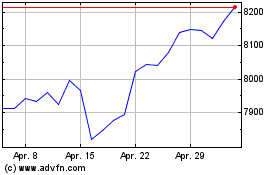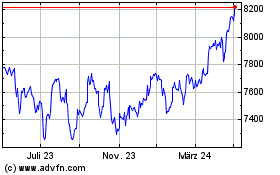By Barbara Kollmeyer, MarketWatch
Asian stocks tumble, with techs bearing the brunt
U.S. stock futures tumbled Thursday, with selling so intense at
one point that circuit breakers were triggered, after the arrest of
a Huawei executive reignited trade worries that helped drag
equities to their worst session since early October on Tuesday.
The market was closed
(http://www.marketwatch.com/story/what-george-hw-bushs-funeral-means-for-stock-market-bond-traders-commodities-2018-12-03)
Wednesday to mark a national day of mourning for former President
George H.W. Bush, who died Friday at 94.
How did the benchmarks fare?
Futures for the Dow Jones Industrial Average were down 332
points, or 1.3%, at 24,715, while those for the S&P 500 index
were off 34.20 points to 2,667.50, a loss of 1.3%, while Nasdaq-100
futures tumbled 117.25 points, or 1.7%, at 6,686.25.
On Tuesday, the Dow sank 799.36 points, or 3.1%, to 25,027.07,
while the S&P 500 index dropped 90.31 points, or 3.2%, to
2,700.06. The Nasdaq Composite Index tumbled 283.09 points, or
3.8%, to 7,158.43. All three benchmarks had their worst day since
Oct. 10.
Read:The worst-performing stocks on 'Tariff Man' Tuesday
(http://www.marketwatch.com/story/here-are-the-worst-performing-stocks-on-tariff-man-tuesday-2018-12-04)
What drove the market?
While regular trading was closed Wednesday, there was a
shortened session of electronic trading for stock-index futures
that showed Dow futures bouncing 100 points. When futures reopened
Thursday, the drop was so severe on S&P 500 futures that the
Chicago Mercantile Exchange triggered circuit breakers
(https://www.fxleaders.com/news/2018/12/06/es-futures-crash-on-reopen-cme-intervenes/)
to avoid worse losses. Those futures spiked down to 2,659, a drop
of 1.9% before the CME stopped trading briefly to try to calm the
market, said Chris Weston, head of research at Pepperstone.
Already jittery investors were rattled further by news that the
Canadian authorities had arrested Meng Wanzhou
(http://www.marketwatch.com/story/huawei-cfo-arrested-in-canada-at-us-request-for-allegedly-breaking-iran-sanctions-2018-12-05),
the chief financial officer of Huawei Technologies, at the request
of U.S. authorities for allegedly violating sanctions against Iran.
The arrest, which was made on Dec. 1, comes as the U.S. has taken
several steps to restrict the Chinese technology giant, trying to
persuade international allies to do the same.
China authorities reacted furiously, with the spokesperson of
the Chinese Embassy in Canada demanding the release of the Huawei
executive (http://ca.china-embassy.org/eng/sgxw/t1619426.htm). "At
the request of the U.S. side, the Canadian side arrested a Chinese
citizen not violating any American or Canadian law," said a
statement on its website. Huawei itself said it was "unaware of any
wrongdoing by Ms. Meng," in a statement released on Twitter.
(https://twitter.com/Huawei/status/1070491220441423872)
The latest development comes amid an already shaky backdrop for
trade relations between the U.S. and China. Doubts surrounding the
weekend trade moratorium at the G-20 summit between the two sides
and ominous developments in the bond market drove sharp losses for
stocks Tuesday.
Investors are also facing a heavy load of economic data Thursday
and the start of a two-day OPEC meeting. That data batch includes
ADP employment for November that will be released at 8:15 a.m.
Eastern Time, followed by weekly jobless claims, the October trade
deficit and third quarter productivity and unit labor costs, all at
8:30 a.m. Eastern.
The Institute for Supply Management's nonmanufacturing index for
November will be released at 10 a.m. Eastern, along with October
factory orders and the quarterly services survey for the third
quarter.
What are strategists saying?
"The timing of the arrest is key here. Markets are already
incredibly nervous over slowing economic growth thanks to the
inverted U.S. yield curve. Relations between the U.S. and China
were supposed to be on the mend after a productive G-20. However,
the arrest has the potential to shatter very fragile U.S.--Sino
relations which will weigh further on global trade and growth
concerns," said Jasper Lawler, head of research at London Capital
Group, in a note to clients.
And "despite recent heavy selloffs, the bottom isn't in sight
and the markets have further to fall. The big swings of late are
representative of a very jittery market," added Lawler.
Read: December historically is the most wonderful time of the
year for stocks
(http://www.marketwatch.com/story/december-historically-is-the-most-wonderful-time-of-the-year-for-stocks-2018-12-03)
What are other markets doing?
Asian stocks fell sharply across the board
(http://www.marketwatch.com/story/asian-markets-plunge-led-by-tech-stocks-after-huawei-execs-arrest-2018-12-05),
with the bulk of losses hitting tech stocks, and the Hong Kong Hang
Seng Index bearing the brunt of losses, dropping nearly 3%. FTSE
100 futures were also pointing to a 1% opening drop.
Benchmark U.S. crude lost 1.2% to $52.25 a barrel. Brent crude ,
used to price international oils, declined 0.8% to $61.09, as
traders awaited clarity on a possible, but far-from-assured, output
cut by major producers gathering in Vienna
(http://www.marketwatch.com/story/oil-prices-slip-as-jitters-persist-around-opec-production-meeting-outcome-2018-12-05).
OPEC will hold its official meeting on Thursday, with another
key meeting between the group's members and nonmember allies to be
held Friday.
Gold prices traded steady, along with the ICE Dollar Index .
(END) Dow Jones Newswires
December 06, 2018 02:16 ET (07:16 GMT)
Copyright (c) 2018 Dow Jones & Company, Inc.
FTSE 100
Index Chart
Von Mär 2024 bis Apr 2024

FTSE 100
Index Chart
Von Apr 2023 bis Apr 2024
